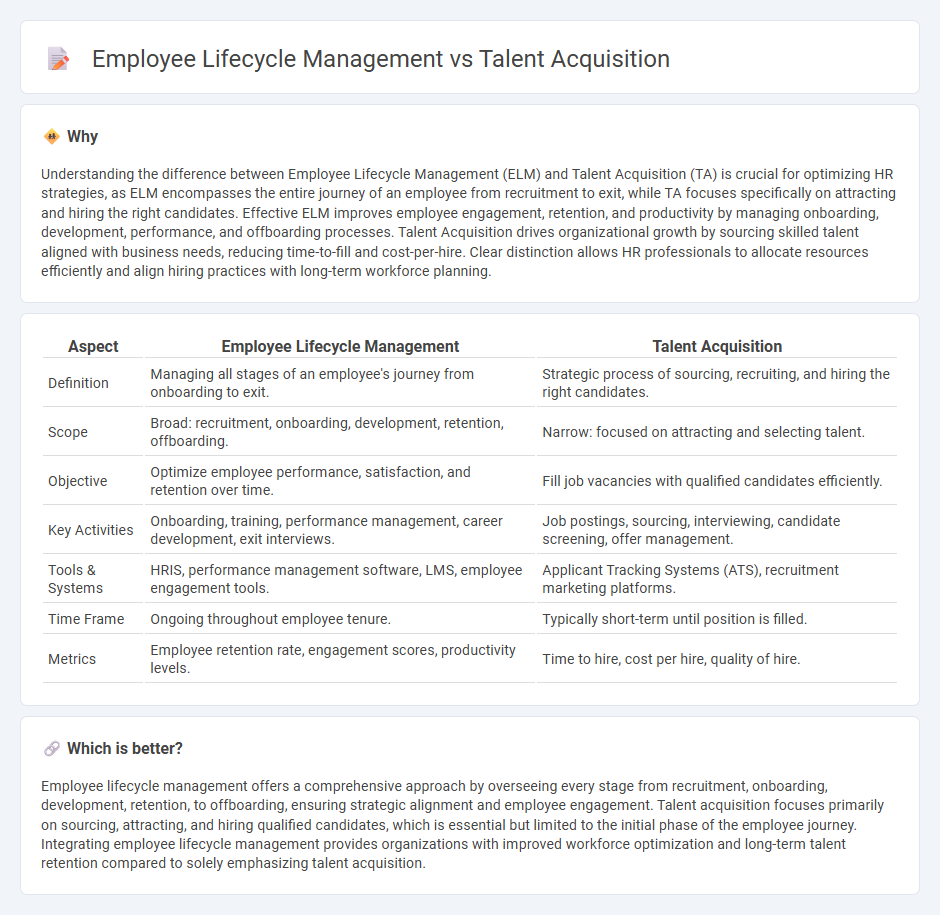
Employee lifecycle management encompasses the entire span of an employee's journey from recruitment, onboarding, development, retention, to exit processes, ensuring a holistic approach to workforce optimization. Talent acquisition focuses specifically on identifying, attracting, and hiring skilled candidates to meet organizational needs, often driven by strategic workforce planning. Explore how integrating both strategies can enhance overall HR effectiveness and drive business success.
Why it is important
Understanding the difference between Employee Lifecycle Management (ELM) and Talent Acquisition (TA) is crucial for optimizing HR strategies, as ELM encompasses the entire journey of an employee from recruitment to exit, while TA focuses specifically on attracting and hiring the right candidates. Effective ELM improves employee engagement, retention, and productivity by managing onboarding, development, performance, and offboarding processes. Talent Acquisition drives organizational growth by sourcing skilled talent aligned with business needs, reducing time-to-fill and cost-per-hire. Clear distinction allows HR professionals to allocate resources efficiently and align hiring practices with long-term workforce planning.
Comparison Table
| Aspect | Employee Lifecycle Management | Talent Acquisition |
|---|---|---|
| Definition | Managing all stages of an employee's journey from onboarding to exit. | Strategic process of sourcing, recruiting, and hiring the right candidates. |
| Scope | Broad: recruitment, onboarding, development, retention, offboarding. | Narrow: focused on attracting and selecting talent. |
| Objective | Optimize employee performance, satisfaction, and retention over time. | Fill job vacancies with qualified candidates efficiently. |
| Key Activities | Onboarding, training, performance management, career development, exit interviews. | Job postings, sourcing, interviewing, candidate screening, offer management. |
| Tools & Systems | HRIS, performance management software, LMS, employee engagement tools. | Applicant Tracking Systems (ATS), recruitment marketing platforms. |
| Time Frame | Ongoing throughout employee tenure. | Typically short-term until position is filled. |
| Metrics | Employee retention rate, engagement scores, productivity levels. | Time to hire, cost per hire, quality of hire. |
Which is better?
Employee lifecycle management offers a comprehensive approach by overseeing every stage from recruitment, onboarding, development, retention, to offboarding, ensuring strategic alignment and employee engagement. Talent acquisition focuses primarily on sourcing, attracting, and hiring qualified candidates, which is essential but limited to the initial phase of the employee journey. Integrating employee lifecycle management provides organizations with improved workforce optimization and long-term talent retention compared to solely emphasizing talent acquisition.
Connection
Employee lifecycle management encompasses all stages from recruitment to exit, making talent acquisition a critical starting point that influences overall workforce quality and retention. Effective talent acquisition ensures a strong candidate pipeline that aligns with organizational goals, directly impacting employee engagement, performance, and development throughout the lifecycle. Integrating recruitment strategies with lifecycle management optimizes workforce planning, reduces turnover, and enhances long-term organizational success.
Key Terms
Recruitment
Talent acquisition concentrates on sourcing, attracting, and hiring top candidates to fulfill organizational needs, emphasizing strategic recruitment and employer branding. Employee lifecycle management encompasses the entire journey of an employee from onboarding through development and retention, ensuring engagement and productivity beyond just hiring. Discover how integrating both approaches enhances recruitment success and long-term workforce stability.
Onboarding
Talent acquisition emphasizes attracting and hiring the right candidates to fit organizational needs, while employee lifecycle management encompasses the entire journey from recruitment to exit, including onboarding as a critical phase. Onboarding integrates new hires into the company culture, accelerates productivity, and reduces turnover by providing essential training and resources. Explore deeper insights into how effective onboarding bridges talent acquisition and long-term employee success.
Retention
Talent acquisition targets attracting and hiring the right candidates, focusing on recruitment strategies and employer branding to fill organizational needs efficiently. Employee lifecycle management encompasses the entire journey from onboarding through performance management, professional development, and retention to enhance employee satisfaction and reduce turnover rates. Explore how integrating retention-focused practices within both talent acquisition and lifecycle management can drive sustainable workforce growth and organizational success.
Source and External Links
Talent Acquisition: The Ultimate Guide - This comprehensive guide covers the process of identifying, attracting, selecting, and retaining highly qualified talent, including strategies like Build, Buy, Borrow, and Bridge.
What is Talent Acquisition? Tips & FAQs - This resource provides an overview of talent acquisition, including effective strategies for recruiting and retaining skilled workers while aligning with departmental goals.
Guide To Talent Acquisition - This guide covers the process of finding and retaining highly qualified employees, often used for specialized roles like executive and technical positions.
 dowidth.com
dowidth.com